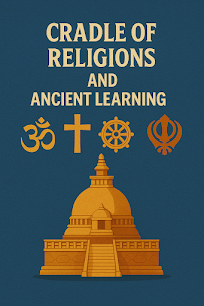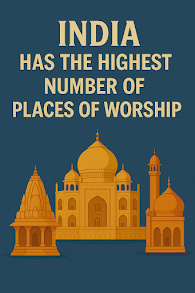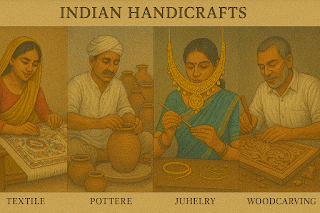Facts About India That Make It a Unique Country in the World
India, a land of ancient wisdom and futuristic ambitions, is one of the most fascinating countries on Earth. Known for its incredible diversity, rich culture, deep-rooted traditions, and rapid development, India captivates people worldwide. Whether you’re exploring its heritage, marveling at its architecture, or diving into its festivals, you’ll find countless facts about India that make it truly one of a kind.
🌏 1. India – The Seventh Largest Country and the Most Populous Nation
India spans over 3.28 million square kilometers, making it the 7th largest country by land area. In 2023, India became the world’s most populous country, overtaking China, with over 1.43 billion people.
India is divided into 28 states and 8 union territories, and each region has its own unique culture, language, cuisine, and lifestyle. From the Himalayas in the north to the Indian Ocean in the south, India’s vastness offers everything from deserts, forests, and rivers to plateaus and coastal plains.
🗣️ 2. India – Home to 22 Official Languages and Over 19,500 Dialects
India is a multilingual society. The Indian Constitution recognizes 22 scheduled languages under the Eighth Schedule, including Hindi, Bengali, Telugu, Marathi, Tamil, Urdu, and Gujarati.
Besides these, there are over 19,500 spoken languages and dialects recorded across different regions. Hindi is the most widely spoken language, while English is extensively used in official, business, and academic settings.
This vast linguistic diversity reflects India's cultural richness and helps in uniting its people while preserving regional identities.
🎓 3. India – Cradle of Religions and Ancient Learning
India is the birthplace of four major world religions: Hinduism, Buddhism, Jainism, and Sikhism. It has been a spiritual hub for centuries and is home to millions of temples, monasteries, and religious schools.
India was also a pioneer in ancient education. Takshashila University (700 BCE) and Nalanda University (4th century CE) attracted scholars from around the world. Subjects like mathematics, astronomy, medicine, and philosophy were taught in these ancient institutions.
India’s contributions to spiritual and intellectual thought continue to inspire global scholars today.
🛕 4. India Has the Highest Number of Places of Worship
India is known for its deep spirituality and religious tolerance. There are more than 2 million temples, 300,000 mosques, churches, gurudwaras, and monasteries spread across the country.
Some iconic religious landmarks include:
-
Kashi Vishwanath Temple, Varanasi – one of the holiest Hindu temples.
-
Golden Temple, Amritsar – the spiritual center of Sikhism.
-
Ajmer Sharif Dargah, Rajasthan – a sacred Muslim shrine.
-
Velankanni Church, Tamil Nadu – known as the Lourdes of the East.
This diversity makes India a pilgrimage destination for people of many faiths.
🐅 5. India’s National Symbols Represent Pride and Identity
India has several national symbols that reflect its culture, biodiversity, and identity:
-
🐅 National Animal: Bengal Tiger – symbolizes strength and power.
-
🦚 National Bird: Indian Peacock – represents beauty and grace.
-
🌸 National Flower: Lotus – a symbol of purity and spiritual awakening.
-
🌳 National Tree: Banyan – known for longevity and shelter.
-
🇮🇳 National Flag: The Tricolour – saffron (courage), white (peace), green (growth), with the Ashoka Chakra representing law and dharma.
-
🎶 National Anthem: "Jana Gana Mana" – composed by Rabindranath Tagore.
-
💬 National Language: Hindi (official), but English is widely used.
These symbols are taught in schools and celebrated in national events like Republic Day and Independence Day.
🧠 6. India – A Leader in Science, Space and Innovation
India has made remarkable progress in science and technology. Here are some highlights:
-
In 2023, ISRO successfully landed Chandrayaan-3 on the Moon’s south pole, making India the first country to do so.
-
India developed the number zero, the decimal system, and advanced trigonometry concepts.
-
The country is a global leader in pharmaceuticals, information technology, and engineering.
-
Ayurveda and Yoga, ancient Indian health systems, are now accepted worldwide for wellness.
India also produces some of the most skilled engineers, scientists, and doctors in the world.
🎉 7. India Celebrates the Most Number of Festivals Annually
Thanks to its cultural and religious diversity, India celebrates hundreds of festivals every year. Each festival is filled with color, rituals, music, and food.
Major Indian festivals:
-
Diwali – Festival of Lights celebrated across religions.
-
Holi – Festival of Colors marking the arrival of spring.
-
Eid-ul-Fitr – Celebrated by Muslims with joy and feasts.
-
Navratri & Durga Puja – Devoted to Goddess Durga.
-
Christmas – Celebrated widely in Goa, Kerala, and Northeast India.
-
Pongal, Onam, Bihu, Ugadi, Makar Sankranti – Regional harvest festivals.
Each festival has a deep spiritual and historical meaning, and they strengthen social bonds among people.
🏛️ 8. India – A Nation with a Rich Political and Historical Legacy
India's civilizational history dates back over 5,000 years to the Indus Valley Civilization. The country has seen great empires, such as the Mauryas, Guptas, Mughals, and British rule.
India became an independent nation on August 15, 1947, under the leadership of Mahatma Gandhi, Jawaharlal Nehru, and other freedom fighters. The Constitution of India came into force on January 26, 1950, making India a sovereign democratic republic.
India today is the world’s largest democracy, with a vibrant political structure and multiple active political parties.
🧵 9. India – World Leader in Handicrafts and Traditional Textiles
India has been known for its textile and handicraft industry since ancient times. Even in modern times, Indian fabrics are loved globally.
Notable textile traditions:
-
Banarasi Silk Sarees – from Varanasi, with intricate gold brocade.
-
Chikankari Embroidery – from Lucknow, delicate hand-embroidery.
-
Bandhani and Leheriya – tie-dye techniques from Rajasthan and Gujarat.
-
Kanjeevaram Silk – from Tamil Nadu, worn during weddings.
-
Pashmina Shawls – from Kashmir, made of fine goat wool.
Handicrafts like terracotta pottery, woodwork, and handloom products are essential to India’s economy and cultural export.
💡 Conclusion: Why India Is a Unique Country in the World
India is not just a nation; it’s a civilizational experience. From its spiritual depth to its technological rise, from its multilingual society to its cultural unity, India stands as a symbol of unity in diversity.
Whether you’re a traveler, researcher, or student, understanding India means understanding the story of humanity—a story of evolution, resilience, and harmony.
❓ Frequently Asked Questions (FAQ)
Q1. Why is India considered unique?
India stands out for its incredible diversity — in language, religion, geography, food, and history. It’s home to ancient civilizations, modern tech hubs, and world-renowned cultural traditions.
Q2. What are some surprising facts about India?
India is where chess originated, has the world’s largest vegetarian population, invented zero, and is home to the wettest place on Earth — Mawsynram.
Q3. Is India the world’s largest democracy?
Yes, with over 900 million eligible voters, India is the largest democracy in the world.
Q4. What is India’s contribution to science and mathematics?
India gave the world zero, advanced astronomy, surgery techniques, and the decimal system — long before they spread to the West.
Q5. How diverse is India?
India has 22 official languages, over 1,600 dialects, multiple religions, and customs that vary dramatically from one region to another.





















0 Comments